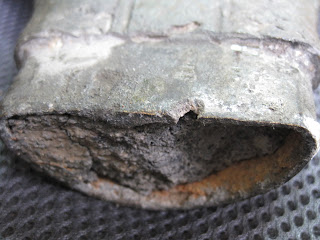Beautiful and unique marble statue; probably used to be a set but just have the one. Discovered it in the ruins of an old house in Southern Taiwan. Pretty sure it's marble. Extremely heavy. Base is 12x6.5. Signed with Chinese character stamp carved in.
Not sure about the history...
Derek Murphy infrequently uses this Taiwan blog about contemporary Asian art, life in Taiwan, studying in Taiwan, teaching English in Taiwan, and other stuff that doesn't fit on my other web pages.
Monday, March 29, 2010
18th century Japanese Ivory owl carving
Recently inherited this piece from the family estate; was given to my mother as a child from an older relative. There is a signature on the base in (japanese?) characters. Based on similar items, my best guess is that this is carved Japanese ivory, probably 18th/19th century. The eyes and feet are painted yellow, a little carelessly. This may have been done later. The feet are metal/ivory.
The piece is pretty heavy; maybe mammoth?
What do you think it is? Value estimate?
The piece is pretty heavy; maybe mammoth?
What do you think it is? Value estimate?
12th Century Khmer Bronze Figure of Buddha Muchalinda
I've had this piece for years and am suddenly aware that it might be very valuable; if authentic. The style of the piece is most similar (identical) to pieces from the 12th century Cambodia, Angkor Thom or Khmer region. It's 16" tall, the base is 4.5x3". It is "well cast and sensitively modeled, with Buddha seated in meditation on the coils of Muchalinda, rising to form a seven-headed hood sheltering Buddha, his face with a serene expression with downcast eyes and hands held in his lap, the faces of the nagas well defined and with incised scales retaining original gilding, with a smooth blue green patina (which results from azurite leeching out of the metal over the centuries)" (description modified from similar item).
I have no way of telling whether it is truly 8 centuries old or was cleverly made to look that way; I need an expert appraiser for this. However, I've seen no 'fakes' or reproductions that look like this; everything I can find that's similar sells for anywhere between $1000 to $50,000... My piece is unique in that it breaks into 3 pieces - base, seated buddha, and 7 naga backpiece. I have seen other statues of the same period where the Buddha also was loose from its supporting stand. So what do you think? Authentic? Value?
MORE INFORMATION:
In Buddhist iconography, naga serpents bring wisdom and protection. Mucalinda, Muchalinda or Mucilinda is the name of the specific naga depicted in this statue. This particular naga protected the Buddha from the a rain storm after the Buddha's enlightenment. Here's the story: four weeks after Sakyamuni Buddha began meditating under the Bodhi tree, the heavens darkened for seven days, and a prodigious rain descended. The mighty king of serpents, Mucalinda, came from beneath the earth, and protected with his hood He who is the source of all protection. When the great storm cleared, the serpent king assumed his human form, bowed before the Buddha, and returned in joy to his palace.
There are numerous extant Cambodian images of this configuration because it was the focus of a cult during the reign of the Cambodian king Jayavarman VII, who ruled the Khmer empire from about 1181 to 1218. Although this scene had been depicted earlier in South and Southeast Asian art, it was the Khmer who popularized this particular image of the Buddha seated under the Naga's 7-Headed canopy. The reasons that Jayavarman chose to stress the Muchilinda Buddha remain speculative. Snakes were associated with healing, and perhaps because Jayavarman may have been lame, he emphasized healing, as indicated by his construction of hospitals throughout the kingdom.
I have no way of telling whether it is truly 8 centuries old or was cleverly made to look that way; I need an expert appraiser for this. However, I've seen no 'fakes' or reproductions that look like this; everything I can find that's similar sells for anywhere between $1000 to $50,000... My piece is unique in that it breaks into 3 pieces - base, seated buddha, and 7 naga backpiece. I have seen other statues of the same period where the Buddha also was loose from its supporting stand. So what do you think? Authentic? Value?
MORE INFORMATION:
In Buddhist iconography, naga serpents bring wisdom and protection. Mucalinda, Muchalinda or Mucilinda is the name of the specific naga depicted in this statue. This particular naga protected the Buddha from the a rain storm after the Buddha's enlightenment. Here's the story: four weeks after Sakyamuni Buddha began meditating under the Bodhi tree, the heavens darkened for seven days, and a prodigious rain descended. The mighty king of serpents, Mucalinda, came from beneath the earth, and protected with his hood He who is the source of all protection. When the great storm cleared, the serpent king assumed his human form, bowed before the Buddha, and returned in joy to his palace.
There are numerous extant Cambodian images of this configuration because it was the focus of a cult during the reign of the Cambodian king Jayavarman VII, who ruled the Khmer empire from about 1181 to 1218. Although this scene had been depicted earlier in South and Southeast Asian art, it was the Khmer who popularized this particular image of the Buddha seated under the Naga's 7-Headed canopy. The reasons that Jayavarman chose to stress the Muchilinda Buddha remain speculative. Snakes were associated with healing, and perhaps because Jayavarman may have been lame, he emphasized healing, as indicated by his construction of hospitals throughout the kingdom.
Subscribe to:
Posts (Atom)















